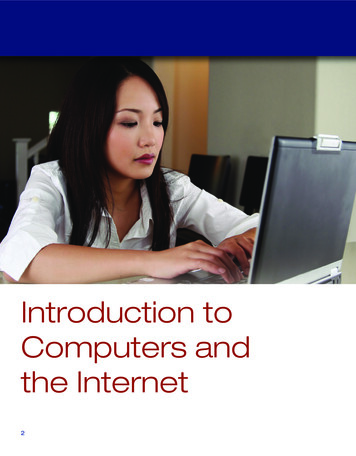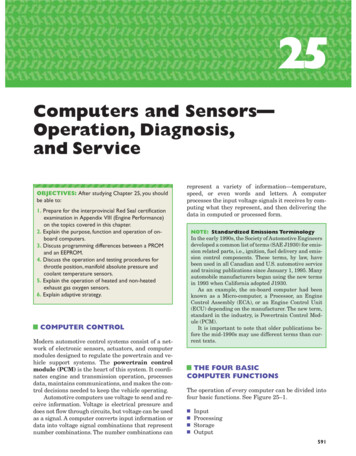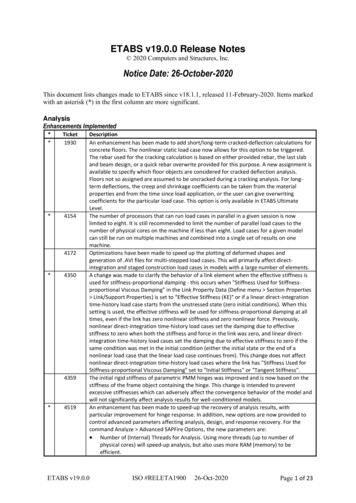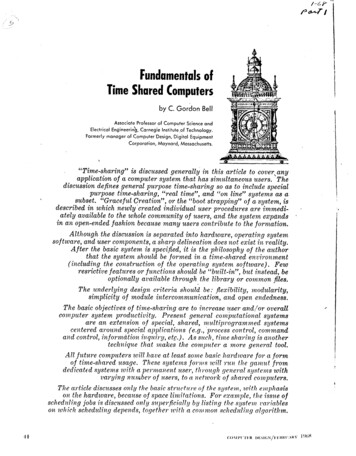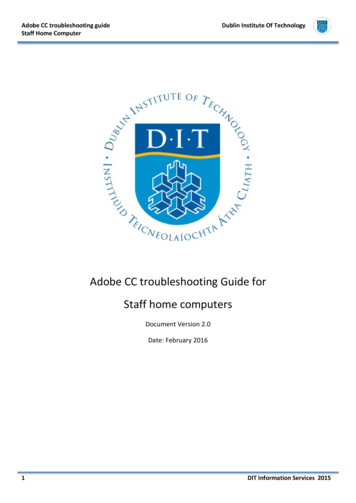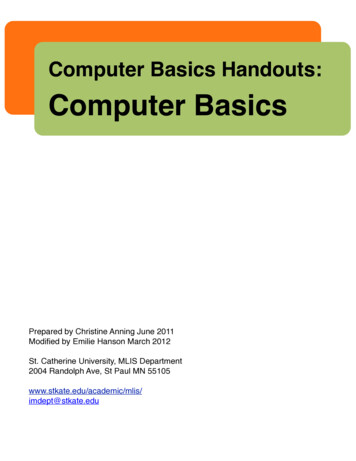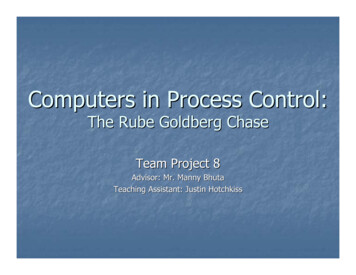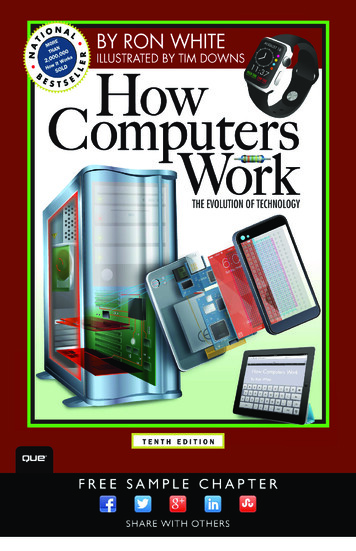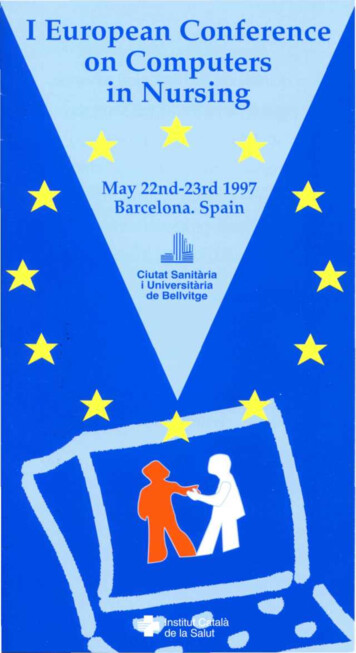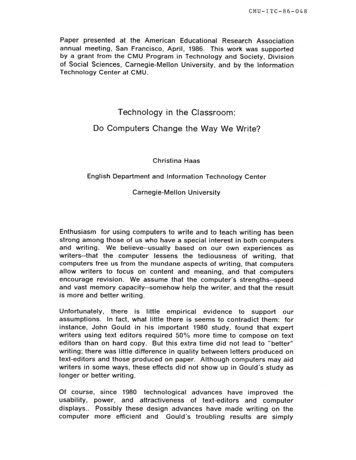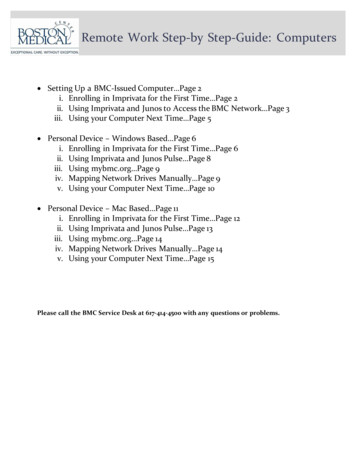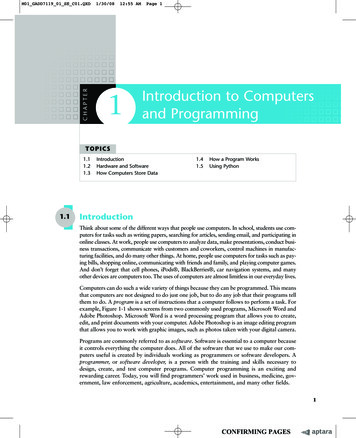
Transcription
CHAPTERM01 GADD7119 01 SE C01.QXD1/30/0812:55 AM1Page 1Introduction to Computersand ProgrammingTOPICS1.11.21.31.1IntroductionHardware and SoftwareHow Computers Store Data1.41.5How a Program WorksUsing PythonIntroductionThink about some of the different ways that people use computers. In school, students use computers for tasks such as writing papers, searching for articles, sending email, and participating inonline classes. At work, people use computers to analyze data, make presentations, conduct business transactions, communicate with customers and coworkers, control machines in manufacturing facilities, and do many other things. At home, people use computers for tasks such as paying bills, shopping online, communicating with friends and family, and playing computer games.And don’t forget that cell phones, iPods , BlackBerries , car navigation systems, and manyother devices are computers too. The uses of computers are almost limitless in our everyday lives.Computers can do such a wide variety of things because they can be programmed. This meansthat computers are not designed to do just one job, but to do any job that their programs tellthem to do. A program is a set of instructions that a computer follows to perform a task. Forexample, Figure 1-1 shows screens from two commonly used programs, Microsoft Word andAdobe Photoshop. Microsoft Word is a word processing program that allows you to create,edit, and print documents with your computer. Adobe Photoshop is an image editing programthat allows you to work with graphic images, such as photos taken with your digital camera.Programs are commonly referred to as software. Software is essential to a computer becauseit controls everything the computer does. All of the software that we use to make our computers useful is created by individuals working as programmers or software developers. Aprogrammer, or software developer, is a person with the training and skills necessary todesign, create, and test computer programs. Computer programming is an exciting andrewarding career. Today, you will find programmers’ work used in business, medicine, government, law enforcement, agriculture, academics, entertainment, and many other fields.1
M01 GADD7119 01 SE C01.QXD2Chapter 11/23/085:19 PMPage 2Introduction to Computers and ProgrammingFigure 1-1A word processing program and an image editing programThis book introduces you to the fundamental concepts of computer programming using thePython language. Before we begin exploring those concepts, you need to understand a fewbasic things about computers and how they work. This chapter will build a solid foundation of knowledge that you will continually rely on as you study computer science. First,we will discuss the physical components that computers are commonly made of. Next, wewill look at how computers store data and execute programs. Finally, we will get a quickintroduction to the software that you will use to write Python programs.1.2Hardware and SoftwareCONCEPT: The physical devices that a computer is made of are referred to as thecomputer’s hardware. The programs that run on a computer are referredto as software.HardwareThe term hardware refers to all of the physical devices, or components, that a computer is madeof. A computer is not one single device, but a system of devices that all work together. Like thedifferent instruments in a symphony orchestra, each device in a computer plays its own part.If you have ever shopped for a computer, you’ve probably seen sales literature listing components such as microprocessors, memory, disk drives, video displays, graphics cards, andso on. Unless you already know a lot about computers, or at least have a friend that does,understanding what these different components do might be challenging. As shown inFigure 1-2, a typical computer system consists of the following major components: The central processing unit (CPU)Main memorySecondary storage devicesInput devicesOutput devices
M01 GADD7119 01 SE C01.QXD1/24/087:48 AMPage 31.2 Hardware and SoftwareFigure 1-2Typical components of a computer systemCentral ProcessingUnitOutputDevicesInputDevicesMain Memory(RAM)SecondaryStorage DevicesLet’s take a closer look at each of these components.The CPUWhen a computer is performing the tasks that a program tells it to do, we say that the computer is running or executing the program. The central processing unit, or CPU, is the partof a computer that actually runs programs. The CPU is the most important component ina computer because without it, the computer could not run software.In the earliest computers, CPUs were huge devices made of electrical and mechanicalcomponents such as vacuum tubes and switches. Figure 1-3 shows such a device.The two women in the photo are working with the historic ENIAC computer. TheENIAC, which is considered by many to be the world’s first programmable electroniccomputer, was built in 1945 to calculate artillery ballistic tables for the U.S. Army. Thismachine, which was primarily one big CPU, was 8 feet tall, 100 feet long, and weighed30 tons.Today, CPUs are small chips known as microprocessors. Figure 1-4 shows a photo of a labtechnician holding a modern microprocessor. In addition to being much smaller than theold electromechanical CPUs in early computers, microprocessors are also much morepowerful.3
M01 GADD7119 01 SE C01.QXD4Chapter 11/23/085:19 PMPage 4Introduction to Computers and ProgrammingFigure 1-3The ENIAC computer (courtesy of U.S. Army Historic Computer Images)Figure 1-4A lab technician holds a modern microprocessor (photo courtesy of IntelCorporation)Main MemoryYou can think of main memory as the computer’s work area. This is where the computerstores a program while the program is running, as well as the data that the program isworking with. For example, suppose you are using a word processing program to write an
M01 GADD7119 01 SE C01.QXD1/23/085:19 PMPage 51.2 Hardware and Softwareessay for one of your classes. While you do this, both the word processing program and theessay are stored in main memory.Main memory is commonly known as random-access memory, or RAM. It is called thisbecause the CPU is able to quickly access data stored at any random location in RAM.RAM is usually a volatile type of memory that is used only for temporary storage whilea program is running. When the computer is turned off, the contents of RAM areerased. Inside your computer, RAM is stored in chips, similar to the ones shown inFigure 1-5.Figure 1-5Memory chips (photo courtesy of IBM Corporation)Secondary Storage DevicesSecondary storage is a type of memory that can hold data for long periods of time, evenwhen there is no power to the computer. Programs are normally stored in secondarymemory and loaded into main memory as needed. Important data, such as word processing documents, payroll data, and inventory records, is saved to secondary storageas well.The most common type of secondary storage device is the disk drive. A disk drive storesdata by magnetically encoding it onto a circular disk. Most computers have a disk drivemounted inside their case. External disk drives, which connect to one of the computer’scommunication ports, are also available. External disk drives can be used to create backupcopies of important data or to move data to another computer.In addition to external disk drives, many types of devices have been created for copyingdata, and for moving it to other computers. For many years floppy disk drives were popular. A floppy disk drive records data onto a small floppy disk, which can be removed fromthe drive. Floppy disks have many disadvantages, however. They hold only a small amountof data, are slow to access data, and can be unreliable. The use of floppy disk drives hasdeclined dramatically in recent years, in favor of superior devices such as USB drives. USBdrives are small devices that plug into the computer’s USB (universal serial bus) port, and5
M01 GADD7119 01 SE C01.QXD6Chapter 11/23/085:19 PMPage 6Introduction to Computers and Programmingappear to the system as a disk drive. These drives do not actually contain a disk, however.They store data in a special type of memory known as flash memory. USB drives, which arealso known as memory sticks and flash drives, are inexpensive, reliable, and small enoughto be carried in your pocket.Optical devices such as the CD (compact disc) and the DVD (digital versatile disc) are alsopopular for data storage. Data is not recorded magnetically on an optical disc, but is encodedas a series of pits on the disc surface. CD and DVD drives use a laser to detect the pits andthus read the encoded data. Optical discs hold large amounts of data, and because recordableCD and DVD drives are now commonplace, they are good mediums for creating backupcopies of data.Input DevicesInput is any data the computer collects from people and from other devices. The component that collects the data and sends it to the computer is called an input device. Commoninput devices are the keyboard, mouse, scanner, microphone, and digital camera. Diskdrives and optical drives can also be considered input devices because programs and dataare retrieved from them and loaded into the computer’s memory.Output DevicesOutput is any data the computer produces for people or for other devices. It might be asales report, a list of names, or a graphic image. The data is sent to an output device, whichformats and presents it. Common output devices are video displays and printers. Diskdrives and CD recorders can also be considered output devices because the system sendsdata to them in order to be saved.SoftwareIf a computer is to function, software is not optional. Everything that a computer does,from the time you turn the power switch on until you shut the system down, is under thecontrol of software. There are two general categories of software: system software andapplication software. Most computer programs clearly fit into one of these two categories.Let’s take a closer look at each.System SoftwareThe programs that control and manage the basic operations of a computer are generallyreferred to as system software. System software typically includes the following types ofprograms:Operating Systems An operating system is the most fundamental set of programs on acomputer. The operating system controls the internal operations of the computer’shardware, manages all of the devices connected to the computer, allows data to be savedto and retrieved from storage devices, and allows other programs to run on the computer.Figure 1-6 shows screens from three popular operating systems: Windows Vista, Mac OSX, and Linux.
M01 GADD7119 01 SE C01.QXD1/23/085:19 PMPage 71.2 Hardware and SoftwareFigure 1-6Screens from the Windows Vista, Mac OS X, and Fedora Linux operating systemsWindows VistaMac OS XFedora LinuxUtility Programs A utility program performs a specialized task that enhances the computer’s operation or safeguards data. Examples of utility programs are virus scanners,file compression programs, and data backup programs.Software Development Tools Software development tools are the programs that programmers use to create, modify, and test software. Assemblers, compilers, and interpreters are examples of programs that fall into this category.Application SoftwarePrograms that make a computer useful for everyday tasks are known as application software. These are the programs that people normally spend most of their time running ontheir computers. Figure 1-1, at the beginning of this chapter, shows screens from twocommonly used applications: Microsoft Word, a word processing program, and AdobePhotoshop, an image editing program. Some other examples of application software arespreadsheet programs, email programs, web browsers, and game programs.Checkpoint1.1What is a program?1.2What is hardware?1.3List the five major components of a computer system.1.4What part of the computer actually runs programs?7
M01 GADD7119 01 SE C01.QXD8Chapter 11.31/23/085:19 PMPage 8Introduction to Computers and Programming1.5What part of the computer serves as a work area to store a program and its datawhile the program is running?1.6What part of the computer holds data for long periods of time, even when there isno power to the computer?1.7What part of the computer collects data from people and from other devices?1.8What part of the computer formats and presents data for people or otherdevices?1.9What fundamental set of programs control the internal operations of thecomputer’s hardware?1.10What do you call a program that performs a specialized task, such as a virusscanner, a file compression program, or a data backup program?1.11Word processing programs, spreadsheet programs, email programs, web browsers,and game programs belong to what category of software?How Computers Store DataCONCEPT: All data that is stored in a computer is converted to sequences of 0sand 1s.A computer’s memory is divided into tiny storage locations known as bytes. One byte isonly enough memory to store a letter of the alphabet or a small number. In order to do anything meaningful, a computer has to have lots of bytes. Most computers today have millions, or even billions, of bytes of memory.Each byte is divided into eight smaller storage locations known as bits. The term bit standsfor binary digit. Computer scientists usually think of bits as tiny switches that can be eitheron or off. Bits aren’t actual “switches,” however, at least not in the conventional sense. Inmost computer systems, bits are tiny electrical components that can hold either a positiveor a negative charge. Computer scientists think of a positive charge as a switch in the onposition, and a negative charge as a switch in the off position. Figure 1-7 shows the waythat a computer scientist might think of a byte of memory: as a collection of switches thatare each flipped to either the on or off position.Figure 1-7Think of a byte as eight switchesONOFFONOFFOFFONONOFF
M01 GADD7119 01 SE C01.QXD1/23/085:19 PMPage 91.3 How Computers Store DataWhen a piece of data is stored in a byte, the computer sets the eight bits to an on/off pattern that represents the data. For example, the pattern shown on the left in Figure 1-8shows how the number 77 would be stored in a byte, and the pattern on the right showshow the letter A would be stored in a byte. We explain below how these patterns aredetermined.Figure 1-8Bit patterns for the number 77 and the letter AONOFFONOFFOFFONONOFFONOFFThe number 77 stored in a byte.ONOFFOFFOFFOFFOFFThe letter A stored in a byte.Storing NumbersA bit can be used in a very limited way to represent numbers. Depending on whether thebit is turned on or off, it can represent one of two different values. In computer systems, abit that is turned off represents the number 0 and a bit that is turned on represents the number 1. This corresponds perfectly to the binary numbering system. In the binary numberingsystem (or binary, as it is usually called) all numeric values are written as sequences of 0sand 1s. Here is an example of a number that is written in binary:10011101The position of each digit in a binary number has a value assigned to it. Starting with therightmost digit and moving left, the position values are 20, 21, 22, 23, and so forth, as shownin Figure 1-9. Figure 1-10 shows the same diagram with the position values calculated.Starting with the rightmost digit and moving left, the position values are 1, 2, 4, 8, and soforth.Figure 1-9The values of binary digits as powers of 21001110120212223242526279
M01 GADD7119 01 SE C01.QXD10Chapter 11/23/085:19 PMPage 10Introduction to Computers and ProgrammingFigure 1-10The values of binary digits100111011248163264128To determine the value of a binary number you simply add up the position values of all the1s. For example, in the binary number 10011101, the position values of the 1s are 1, 4, 8,16, and 128. This is shown in Figure 1-11. The sum of all of these position values is 157.So, the value of the binary number 10011101 is 157.Figure 1-11Determining the value of 1001110110011101148161281 4 8 16 128 157Figure 1-12 shows how you can picture the number 157 stored in a byte of memory. Each1 is represented by a bit in the on position, and each 0 is represented by a bit in the offposition.Figure 1-12The bit pattern for 1571Positionvalues128100643211101684128 16 8 4 1 15721
M01 GADD7119 01 SE C01.QXD1/23/085:19 PMPage 111.3 How Computers Store DataWhen all of the bits in a byte are set to 0 (turned off), then the value of the byte is 0. Whenall of the bits in a byte are set to 1 (turned on), then the byte holds the largest value thatcan be stored in it. The largest value that can be stored in a byte is 1 2 4 8 16 32 64 128 255. This limit exists because there are only eight bits in a byte.What if you need to store a number larger than 255? The answer is simple: use more thanone byte. For example, suppose we put two bytes together. That gives us 16 bits. The position values of those 16 bits would be 20, 21, 22, 23, and so forth, up through 215. As shownin Figure 1-13, the maximum value that can be stored in two bytes is 65,535. If you needto store a number larger than this, then more bytes are necessary.Figure 1-13Two bytes used for a large number1Positionvalues132768 16384118192 4096112048 10241111111111512256128643216842132768 16384 8192 4096 2048 1024 512 256 128 64 32 16 8 4 2 1 65535T I P : In case you’re feeling overwhelmed by all this, relax! You will not have to actually convert numbers to binary while programming. Knowing that this process is taking place inside the computer will help you as you learn, and in the long term thisknowledge will make you a better programmer.Storing CharactersAny piece of data that is stored in a computer’s memory must be stored as a binary number. That includes characters, such as letters and punctuation marks. When a character isstored in memory, it is first converted to a numeric code. The numeric code is then storedin memory as a binary number.Over the years, different coding schemes have been developed to represent characters incomputer memory. Historically, the most important of these coding schemes is ASCII,which stands for the American Standard Code for Information Interchange. ASCII is a setof 128 numeric codes that represent the English letters, various punctuation marks, andother characters. For example, the ASCII code for the uppercase letter A is 65. When youtype an uppercase A on your computer keyboard, the number 65 is stored in memory (as abinary number, of course). This is shown in Figure 1-14.Figure 1-14The letter A is stored in memory as the number 65A651100000011
M01 GADD7119 01 SE C01.QXD12Chapter 11/24/087:48 AMPage 12Introduction to Computers and ProgrammingT I P : The acronym ASCII is pronounced “askee.”In case you are curious, the ASCII code for uppercase B is 66, for uppercase C is 67,and so forth. Appendix C shows all of the ASCII codes and the characters they represent.The ASCII character set was developed in the early 1960s, and was eventually adopted bymost all computer manufacturers. ASCII is limited however, because it defines codes foronly 128 characters. To remedy this, the Unicode character set was developed in the early1990s. Unicode is an extensive encoding scheme that is compatible with ASCII, but can alsorepresent characters for many of the languages in the world. Today, Unicode is quicklybecoming the standard character set used in the computer industry.Advanced Number StorageEarlier you read about numbers and how they are stored in memory. While reading thatsection, perhaps it occurred to you that the binary numbering system can be used to represent only integer numbers, beginning with 0. Negative numbers and real numbers (such as3.14159) cannot be represented using the simple binary numbering technique we discussed.Computers are able to store negative numbers and real numbers in memory, but to do sothey use encoding schemes along with the binary numbering system. Negative numbers areencoded using a technique known as two’s complement, and real numbers are encoded infloating-point notation. You don’t need to know how these encoding schemes work, onlythat they are used to convert negative numbers and real numbers to binary format.Other Types of DataComputers are often referred to as digital devices. The term digital can be used to describeanything that uses binary numbers. Digital data is data that is stored in binary, and a digitaldevice is any device that works with binary data. In this section we have discussed hownumbers and characters are stored in binary, but computers also work with many othertypes of digital data.For example, consider the pictures that you take with your digital camera. These imagesare composed of tiny dots of color known as pixels. (The term pixel stands for pictureelement.) As shown in Figure 1-15, each pixel in an image is converted to a numeric codethat represents the pixel’s color. The numeric code is stored in memory as a binary number.Figure 1-15A digital image is stored in binary format101110100 00011010101101
M01 GADD7119 01 SE C01.QXD1/23/085:19 PMPage 131.4 How a Program WorksThe music that you play on your CD player, iPod or MP3 player is also digital. A digitalsong is broken into small pieces known as samples. Each sample is converted to a binarynumber, which can be stored in memory. The more samples that a song is divided into,the more it sounds like the original music when it is played back. A CD quality song isdivided into more than 44,000 samples per second!Checkpoint1.41.12What amount of memory is enough to store a letter of the alphabet or a small number?1.13What do you call a tiny “switch” that can be set to either on or off?1.14In what numbering system are all numeric values written as sequences of 0s and 1s?1.15What is the purpose of ASCII?1.16What encoding scheme is extensive enough to represent the characters of many ofthe languages in the world?1.17What do the terms “digital data” and “digital device” mean?How a Program WorksCONCEPT: A computer’s CPU can only understand instructions that are written inmachine language. Because people find it very difficult to write entireprograms in machine language, other programming languages have beeninvented.Earlier, we stated that the CPU is the most important component in a computer because itis the part of the computer that runs programs. Sometimes the CPU is called the “computer’sbrain,” and is described as being “smart.” Although these are common metaphors, youshould understand that the CPU is not a brain, and it is not smart. The CPU is an electronicdevice that is designed to do specific things. In particular, the CPU is designed to performoperations such as the following: Reading a piece of data from main memoryAdding two numbersSubtracting one number from another numberMultiplying two numbersDividing one number by another numberMoving a piece of data from one memory location to anotherDetermining whether one value is equal to another valueAs you can see from this list, the CPU performs simple operations on pieces of data. TheCPU does nothing on its own, however. It has to be told what to do, and that’s the purposeof a program. A program is nothing more than a list of instructions that cause the CPU toperform operations.Each instruction in a program is a command that tells the CPU to perform a specific operation. Here’s an example of an instruction that might appear in a program:1011000013
M01 GADD7119 01 SE C01.QXD14Chapter 11/23/085:19 PMPage 14Introduction to Computers and ProgrammingTo you and me, this is only a series of 0s and 1s. To a CPU, however, this is an instructionto perform an operation.1 It is written in 0s and 1s because CPUs only understand instructions that are written in machine language, and machine language instructions always havean underlying binary structure.A machine language instruction exists for each operation that a CPU is capable of performing. For example, there is an instruction for adding numbers, there is an instruction for subtracting one number from another, and so forth. The entire set of instructions that a CPUcan execute is known as the CPU’s instruction set.N O T E : There are several microprocessor companies today that manufacture CPUs.Some of the more well-known microprocessor companies are Intel, AMD, andMotorola. If you look carefully at your computer, you might find a tag showing a logofor its microprocessor.Each brand of microprocessor has its own unique instruction set, which is typicallyunderstood only by microprocessors of the same brand. For example, Intel microprocessors understand the same instructions, but they do not understand instructionsfor Motorola microprocessors.The machine language instruction that was previously shown is an example of only oneinstruction. It takes a lot more than one instruction, however, for the computer to doanything meaningful. Because the operations that a CPU knows how to perform are sobasic in nature, a meaningful task can be accomplished only if the CPU performs manyoperations. For example, if you want your computer to calculate the amount of interest that you will earn from your savings account this year, the CPU will have toperform a large number of instructions, carried out in the proper sequence. It is notunusual for a program to contain thousands or even millions of machine languageinstructions.Programs are usually stored on a secondary storage device such as a disk drive. When youinstall a program on your computer, the program is typically copied to your computer’s diskdrive from a CD-ROM, or perhaps downloaded from a website.Although a program can be stored on a secondary storage device such as a disk drive,it has to be copied into main memory, or RAM, each time the CPU executes it. Forexample, suppose you have a word processing program on your computer’s disk. Toexecute the program you use the mouse to double-click the program’s icon. This causesthe program to be copied from the disk into main memory. Then, the computer’s CPUexecutes the copy of the program that is in main memory. This process is illustrated inFigure 1-16.1 The example shown is an actual instruction for an Intel microprocessor. It tells the microprocessor to move avalue into the CPU.
M01 GADD7119 01 SE C01.QXD1/24/087:48 AMPage 151.4 How a Program WorksFigure 1-16A program is copied into main memory and then executedThe program is copiedfrom secondary storageto main memory.The CPU executesthe program inmain memory.Main memory(RAM)Disk driveCPUWhen a CPU executes the instructions in a program, it is engaged in a process that is knownas the fetch-decode-execute cycle. This cycle, which consists of three steps, is repeated foreach instruction in the program. The steps are:1. Fetch A program is a long sequence of machine language instructions. The first step of thecycle is to fetch, or read, the next instruction from memory into the CPU.2. Decode A machine language instruction is a binary number that represents a command that tells the CPU to perform an operation. In this step the CPU decodes theinstruction that was just fetched from memory, to determine which operation itshould perform.3. Execute The last step in the cycle is to execute, or perform, the operation.Figure 1-17 illustrates these steps.Figure 1-17The fetch-decode-execute 1100and so forth.Fetch the next instructionin the program.2Decode the instructionto determine whichoperation to perform.3Execute the instruction(perform the operation).CPUMain memory(RAM)From Machine Language to Assembly LanguageComputers can only execute programs that are written in machine language. As previouslymentioned, a program can have thousands or even millions of binary instructions, and writingsuch a program would be very tedious and time consuming. Programming in machine languagewould also be very difficult because putting a 0 or a 1 in the wrong place will cause an error.15
M01 GADD7119 01 SE C01.QXD16Chapter 11/23/085:19 PMPage 16Introduction to Computers and ProgrammingAlthough a computer’s CPU only understands machine language, it is impractical for peopleto write programs in machine language. For this reason, assembly language was created in theearly days of computing2 as an alternative to machine language. Instead of using binary numbers for instructions, assembly language uses short words that are known as mnemonics. Forexample, in assembly language, the mnemonic add typically means to add numbers, mul typically means to multiply numbers, and mov typically means to move a value to a location inmemory. When a programmer uses assembly language to write a program, he or she can writeshort mnemonics instead of binary numbers.N O T E : There are many different versions of assembly language. It was mentionedearlier that each brand of CPU has its own machine language instruction set. Eachbrand of CPU typically has its own assembly language as well.Assembly language programs cannot be executed by the CPU, however. The CPU onlyunderstands machine language, so a special program known as an assembler is used totranslate an assembly language program to a machine language program. This process isshown in Figure 1-18. The machine language program that is created by the assembler canthen be executed by the CPU.Figure 1-18An assembler translates an assembly language program to a machinelanguage programAssembly languageprogrammov eax, Zadd eax, 2mov Y, eaxand so forth.Machine d so forth.High-Level LanguagesAlthough assembly language makes it unnecessary to write binary machine languageinstructions, it is not without difficulties. Assembly language is primarily a direct substitutefor machine language, and lik
4 Chapter 1 Introduction to Computers and Programming Figure 1-3 The ENIAC computer (courtesy of U.S. Army Historic Computer Images) Figure 1-4 A lab technician holds a modern microprocessor (photo courtesy of Intel Corporation) Main Memory You can think of main memoryas the computer’s work are
